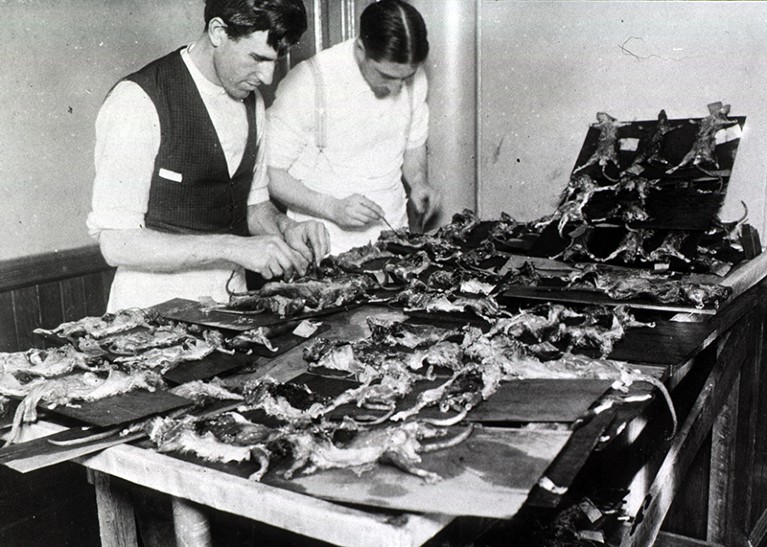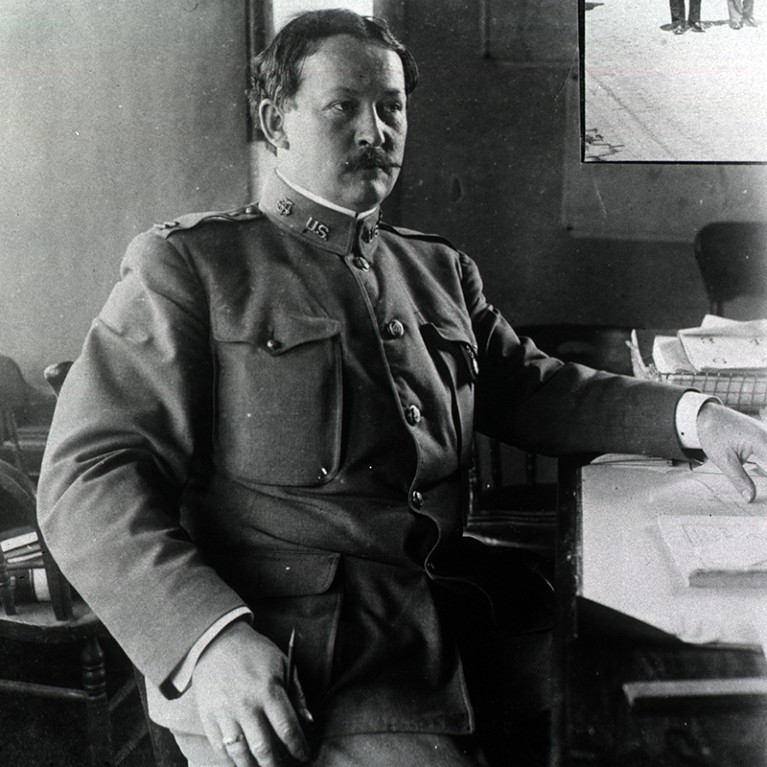
Mass autopsies of rats were crucial to ending San Francisco’s bubonic-plague epidemic.Credit: The National Library of Medicine/Centers for Disease Control
Black Death at the Golden Gate: The Race to Save America from the Bubonic Plague David K. Randall W. W. Norton (2019)
An urban outbreak of a deadly infectious disease with no known cause is a disaster planner’s worst nightmare. In his rousing book Black Death at the Golden Gate, journalist David Randall describes just that: the bubonic-plague epidemic that struck San Francisco, California, in 1900. The race to identify, isolate and halt the disease is set against a rich background of official complacency, financial malfeasance, political intrigues and scientific disputes.
Not least, the story shows how such outbreaks often become sociopolitical crises, triggering official anti-science rhetoric and fear of the ‘other’ — from the ‘Spanish’ influenza pandemic in 1918 (see T. Tansey Nature 546, 207–208; 2017) to the US AIDS crisis of the 1980s, and the current Ebola outbreak in the Democratic Republic of the Congo.
After ravaging Europe and Asia in the fourteenth century, bubonic plague reappeared sporadically. In the late 1870s it emerged in south central China. An outbreak in 1893 killed thousands in Canton, spreading along rivers and steamer routes. At the end of the nineteenth century, plague was identified in a recent Chinese immigrant to the then-independent Hawaiian islands. The pathogen probably crossed from there to San Francisco, on a regular trade route.
The city was notoriously corrupt, dirty and overcrowded. California’s 1848–55 gold rush had swelled the population more than 25-fold. By 1867, Chinese immigrants made up 90% of the workforce building the transcontinental railway. By 1880, some 16% of the population of San Francisco were Chinese. Yet they faced animosity and segregation: the 1882 Chinese Exclusion Act, for instance, cracked down heavily on immigration. Chinatown became San Francisco’s most congested and impoverished district, with ramshackle wooden buildings carved up into tiny, packed spaces. In March 1900, the first suspected plague victim died in one of them.
The bacterium that causes plague, Yersinia pestis, had been identified in 1894, but little was known about transmission, treatment or prevention. As Randall shows, plague was often egregiously framed as a “racial disease” to which people of European ancestry were immune. (This racist fallacy arose in part because European expatriates in colonial India and Hong Kong rarely caught diseases that ravaged the deprived, crowded communities outside their compounds.)
That first case panicked San Francisco’s authorities. They quarantined Chinatown, preventing any movement of food in, or of its inhabitants — many of them cleaners, cooks and labourers — out. Civil unrest ensued, and people began to hide the dead and dying from “wolf doctors” — the city’s health inspectors. Outside Chinatown, the middle-class white population was outraged by the disruption. A definitive diagnosis was needed.
One of the few public-health officials able to provide that diagnosis had arrived in San Francisco not long beforehand. Joseph Kinyoun was a veteran of the federal Marine Hospital Service (MHS) in Washington DC, the Bellevue Hospital in New York City (see D. Dobbs Nature 539, 354–355; 2016) and the European labs of Louis Pasteur and Robert Koch. His growing reputation had irked his boss, surgeon-general Walter Wyman, who exiled him to California.
Kinyoun’s tests on samples from the first suspected victim confirmed the presence of plague. Yet political and popular pressure had already led the local Board of Health to lift the quarantine. From that point, Kinyoun was at war with more than a bacillus. As Randall shows, medical authorities, politicians, the press and the quarantine-averse public resisted his efforts. Kinyoun was hampered, too, by intellectual arrogance and a dearth of local contacts (he was based at an isolation hospital on Angel Island in San Francisco Bay).
Most city health officials refused to implement Kinyoun’s suggestions for inspection, selective quarantine and inoculation with a still-experimental vaccine developed by Russian bacteriologist Waldemar Haffkine. City officials went to extraordinary lengths to avoid admitting the plague’s presence. A court case against the MHS, brought by the Chinese Six Companies (a benevolent society protecting Chinese interests) questioned Kinyoun’s medical qualifications: a real doctor practised with patients, not microscopes.
The hostility to science percolated upwards. Texas and Louisiana threatened to close state borders, and California governor Henry Gage — mindful of his state’s annual $25-million fruit harvest and concerned other states would suspect a problem — disparaged “the plague fake” in a letter to US secretary of state John Hay and issued threats to anyone publishing on it. Yet reports reached Washington DC and an independent scientific enquiry was commissioned. Its confirmatory report weeks later did not halt the skulduggery. Gage called the investigation unfair, and organized a state-wide news blackout; Wyman colluded in trying to suppress the report. Yet the news was leaked in early 1901, and both city and state then pledged funding to eradicate the disease and treat patients. Kinyoun, however, was denied vindication. He was dispatched to Michigan and ultimately replaced by the scientifically trained Rupert Blue.

Rupert Blue led much of the campaign to eradicate plague in San Francisco.Credit: The National Library of Medicine/Centers for Disease Control
Blue established an office and lab in Chinatown, and worked with Chinese organizations. But infected people were still being hidden by their families, and disputes persisted between state and city health authorities and the federal MHS. Dismayed, Blue requested a transfer, believing that only a widespread epidemic would ever shake San Francisco from its torpor. That happened in 1903.
Immediately recalled, and with new authority and support, Blue set about disinfecting the city. Starting with Chinatown, earthen basements were concreted, concrete ones flooded with carbolic acid, walls washed with lye, streets asphalted, cesspools filled and decrepit dwellings demolished. Infection discovered elsewhere in the city led Blue to ponder modes of transmission. Suspecting flea-infested rats, he initiated a ferocious eradication campaign. In 1905, convinced the city was safe, Blue again left.
He was recalled twice more. San Francisco’s magnitude-7.9 earthquake in 1906 destroyed some 80% of the city’s infrastructure and left more than 250,000 people homeless, with rats massing over devastated land and open sewers. Blue controlled small outbreaks and left; 16 months later, the disease was back. Returning to the devastated city, Blue — commandeering offices dubbed the Rattery — sent an army of rat catchers into the city, and had hundreds of rodents autopsied daily for signs of plague. To quell complacency, he threatened to quarantine the entire city and prevent the prestigious US Navy battle fleet from docking.
San Francisco was finally declared plague-free in November 1908; four years later, Blue became US surgeon-general.
As Blue noted, the disease had crossed into the wild squirrel population. Today, an average of seven people a year, most of them hikers, are infected in the United States and are treated with antibiotics.
Randall’s account is pacy and gripping. And his examination of the conflicts, prejudices and priorities involved make for sober reading in a world where Ebola clinics are being torched and anti-vaccination movements threaten a resurgence in diseases such as measles. As most public-health authorities agree, the question we need to ask about the next pandemic is not ‘What if?’ but ‘When?’

 Influenza: A viral world war
Influenza: A viral world war
 Nature special: Ebola epidemic
Nature special: Ebola epidemic
 In retrospect: On the Mode of Communication of Cholera
In retrospect: On the Mode of Communication of Cholera








